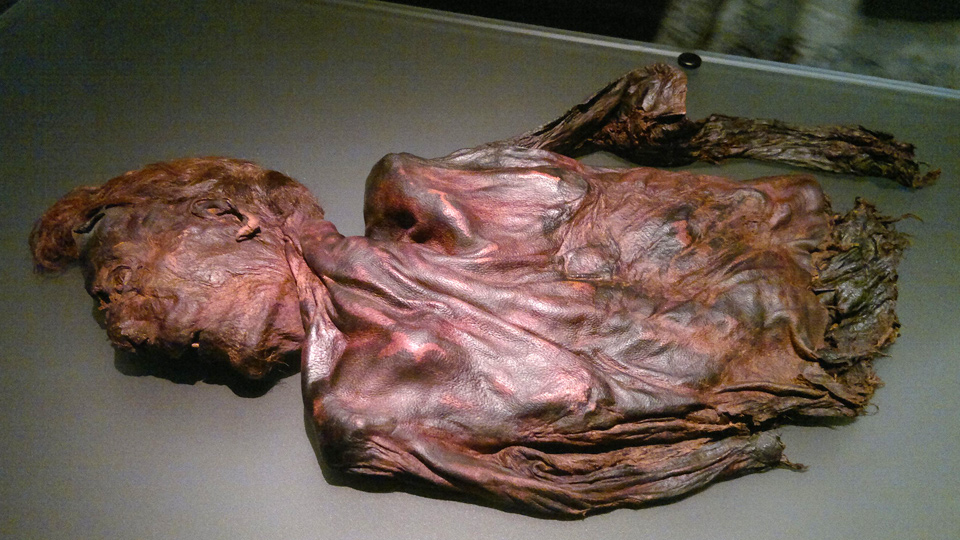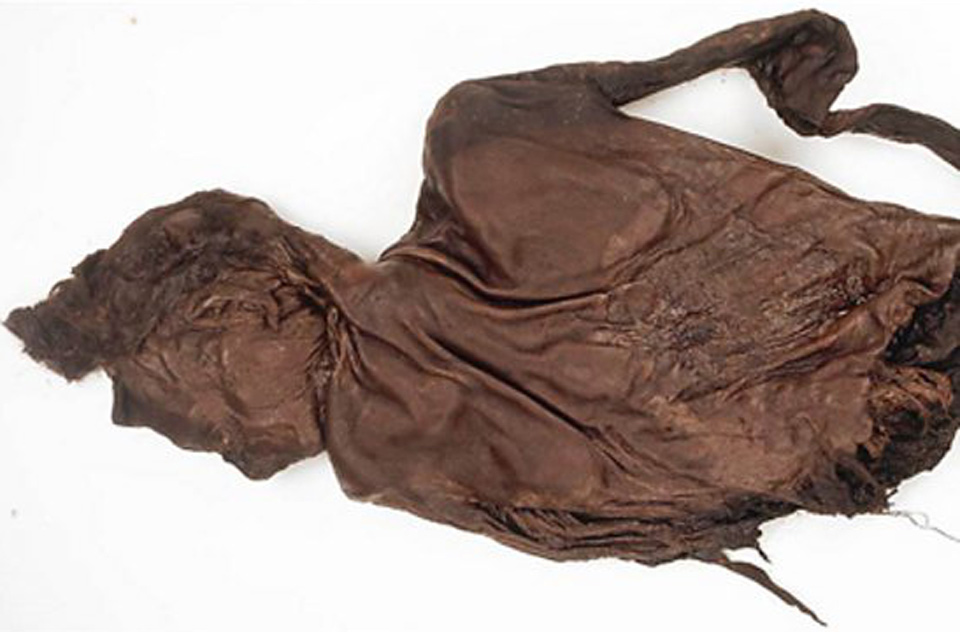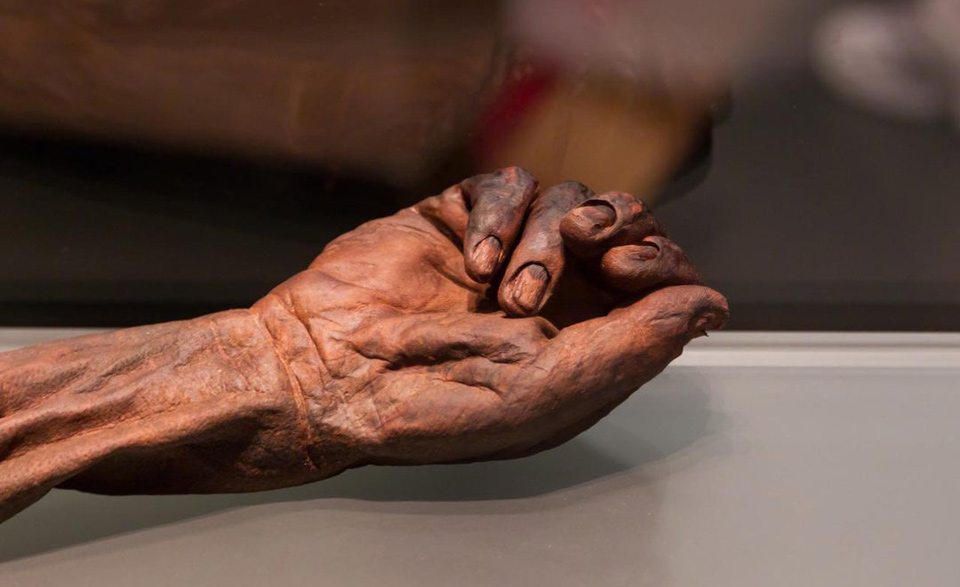ON THIS DAY: 26 MARCH 2003: ClonyCavan Man found
How the Bog Bodies told their story
In March 2003, in a bog on the border of Meath and Offaly, in a place called Clonycavan, a body emerged from the peat beneath the shovel of a cutting machine.
The workers stopped their machinery immediately and after inspecting the body suspected they had unearthed evidence of a gruesome crime.
A Garda examination did confirm that the man in the bog had been murdered, but an examination by an expert from the National Museum of Ireland confirmed that the death had occurred over 2000 years ago.
Coincidentally, only three months later and just 25 miles away, another body emerged from a bog in Old Croghan, Co. Offaly. These two bog bodies were dispatched to the next world in similar ritualized fashion during the Celtic Iron age, and this lead the (then) Keeper of Irish antiquities in the National Museum, Eamonn Kelly, to an interesting theory on sacrifice and kingship.
The forensic investigation that followed revealed an intriguing story which three years later was revealed to the public in the exhibition ‘Kingship and Sacrifice’.
And so, more than 2000 years after his death, Clonycavan man lay motionless on his stomach behind a pane of glass in the National Museum, with his head raised and twisted to one side as if some curious object had caught his interest. His frozen countenance, intent and watchful, with a silent unblinking stare from his one good eye. This glassy black orb suggested an actual window on the past.

ClonyCavan Man
_ _ _ _ _ _ _ _ _ _ _ _ _ _ _ _ _
Distorted by the weight of the bog, which ironically had preserved him from decay, his remains communicate something of the person whom he was. For this is no grinning skull, no grim triumph of time over the finite endurance of mortal life, Clonycavan man is a human form ignored by the passage of time silently staring at a modern world.
Yet Clonycavan man spoke in his own way. He had, and has, a tale to tell.
A forensic examination of his remains, even of the contents of his stomach, told us about his society, their beliefs and ritual practices; the structure of the society he came from; their economic and agricultural systems; and major religious festivals. It even led archaeologists to a new theory on ritual sacrifice and its place in Kingship, and the ties between Kingship and the earth.

Back of ClonyCavan Man
_ _ _ _ _ _ _ _ _ _ _ _ _ _ _ _ _
His hair and hands revealed that he was a person of status. His hands showed no sign of hard labour, perhaps signifying he was a captured warrior or a noble. His hair was styled using a compound containing the sap of a pine tree that now grows only in the Basque region. This really surprised the scientific team as it suggested an established Atlantic trade in luxury goods, pointing to established trade routes over long distances.
The remains of Old Croghan man consisted of a torso with arms outstretched as if in victory. His hands and forearms betrayed a formidable and powerful man approximately 6’3″ in height, but even his obvious strength couldn’t save him from a macabre fate and a grisly end.
His giant torso had been decapitated, a task which must have taken a great deal of strength. The edge of this neck wound was still visible, showing the use of a very sharp blade and a powerful arm. The torso ended a few inches below his rib cage where the lower half of the body had been separated (neither the head nor the hip and lower limbs of the body were found). A close examination of this massive wound revealed a clean, straight cut. The skin itself was perfect, though deeply tanned by the preserving peat. The torso had been ritually desecrated in other ways including the removal of skin from the chest and the insertion of wattle through the biceps.
His stomach contents and hair told another story. While Clonycavan man was murdered at the beginning of winter this warrior was killed at the turning of spring – both major religious festivals in the pre-Christian calendar. He was killed by a stab wound to the chest and had defensive wounds on his arm which may have occurred when he was being killed or may have led to his capture – we will never know.
Like Clonycavan man, the state of his hands and nails would indicate that he was a noble.

Old Croghan Man’s hand
_ _ _ _ _ _ _ _ _ _ _ _ _ _ _ _ _
There have been over 500 bog body finds in Europe since records began, and many of them show the signs of ritual sacrifice to a pre-Christian, Celtic trinity of gods. Back in 2005, Eamon Kelly, then Keeper of Irish antiquities in the National Museum, explained that these two Iron Age bodies dated from an era when ritual sacrifice and bog deposition was an integral part of the north-western European culture.
The two bodies were deposited in the bog in a close time period – and their close chronological proximity, more than their geographical proximity, connected them to a single narrative.
The bodies were in good condition when they were found, although Clonycavan man had been whacked around a bit by the peat cutting machines. However, he had a well-preserved head and recognisable facial features.
In the case of Oldcroghan man, the level of preservation was extraordinary: his hands were immaculate, but the internal organs were also in very good condition.
Bord na Móna workers found the Clonycavan man and immediately consulted their archaeological team and liaised with the National Museum. Oldcroghan man was found on a private bog and the finder immediately informed the gardaí. One of the guards who arrived on the scene had studied archaeology and she got in touch with the Museum. Both these finds were within two months of each other and it generated a lot of excitement, because these finds are very rare nowadays.
Eamonn Kelly recognized that this was a very interesting opportunity to try to get the information that would enable us to understand who these people were, why they were killed, and why they were buried where they were buried.
His investigation unearthed some fascinating things. A human’s hair is like a diary of what he eats. As the hair grows, it records the diet of its owner, so in the case of Clonycavan man, the investigative team were able to find out what he ate for the months previous to his death.
Eamonn explained: “We know that in the Iron Age the diet in the summertime was mainly a vegetable diet but in the winter when vegetable sources were not there, their diet consisted mainly of meat. Clonycavan man had consumed a substantially vegetable-rich diet just before he died.”
“In the case of Oldcroghan man they applied the same principle to his fingernails, which have about four months growth. They showed he had lived on a meat-rich diet for four months prior to his death. But interestingly, his stomach contents showed that his final meal was of buttermilk and cereals so we concluded that he was killed at the beginning of spring. We could be looking at sacrifices to mark the festivals of Samhain and Imbolg.”
“Oldcroghan man did not appear to have put in a day’s work in his life. His hands were completely uncallused – they were as uncallused as those of a modern office worker – and his fingernails showed no sign of chipping. We know from the early Irish historical material that the aristocracy didn’t work the land – kings certainly didn’t. So we can go back into the Iron Age and say that these were important people warriors or kings.”
Eamonn and his team theorized that the two victims were offerings to the gods and were tied to Kingship because in the Iron Age the king took on personal responsibility for the fertility of the earth. It was his task to ensure supplies of corn and other fruits of the earth. He was, in a way, marrying the earth which sustained his people.
“So the king had that responsibility to ensure the fertility of the earth. Also there was a possibility that to ensure the continued fertility of the earth an offering was required – the greatest possible being a human life. The higher the standing of the victim the worthier the sacrifice and then there was the added political benefit of sacrificing your political rivals. Hostages and captive nobility of other tribes would be candidates as offerings to the earth.”
One of the things Eamonn noticed was that the two bodies were found on local tribal boundaries, and so he looked back over the records of bog body finds to check if this was a pattern.
It appeared that there is a pattern – that they usually do lie on ancient political boundaries.
Eamonn said that: “In ancient Ireland the king actually married the land and in the deposition of objects on the perimeter of his tribal boundaries he was making a statement: “I am the king of this land.” It gives actual form and boundaries to this interdependence of Kingship to the earth. This tradition of depositions and offerings was an integral part of Kingship and it lasted into the medieval period, but in different forms. For instance, when a medieval king was inaugurated he gave away his horse and bridle.”
Eamonn explained that “Even the tradition of the land being represented as a woman lasted into the eighteenth-century literal tradition in Ireland, where Ireland was symbolised in the Aislingí in the form of a woman. This is a very, very, old concept.”
Interestingly enough, human sacrifice died out before the Christian period and there are no bog bodies from after the second century AD.
Note: the author was in conversation with Eamonn Kelly in 2006 after the opening of the exhibition ‘Kingship and Sacrifice’ at the national Museum, Kildare Street.
Lorcán Mac Mathúna
This is interesting. I sometimes wonder what would have happened if Ireland had never been Christianized, had never adopted a foreign Mideast religion and stayed with something more indigenous. The human sacrifice isn’t too nice though.